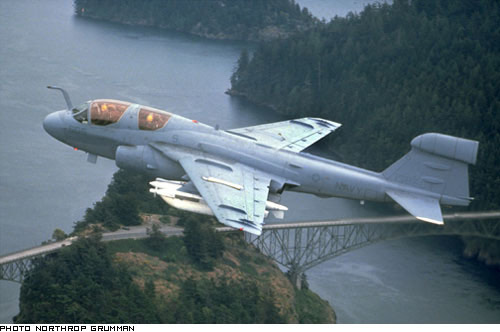EA-6B Prowler
Summary
| Category | Military Special Mission Aircraft |
| Origin country | 🇺🇸 United States |
| Manufacturer | Grumman |
| First flight | 25 May 1968 |
| Year introduced | 1971 |
| Number produced | 170 units |
| Average unit price | $52 million |
Description
During the 1960s, the United States Marine Corps (USMC) sought to procure modern electronic countermeasure (ECM) platforms. This led to the EA-6A "Electric Intruder," a conversion of the Grumman A-6 Intruder with a twin-seat cockpit and electronic warfare equipment. Entering squadron service in December 1965, it saw action in the Vietnam War. Recognizing the need for a more advanced platform, development of the EA-6B commenced in 1966 to replace the United States Navy's EKA-3B Skywarriors. The redesign included lengthening the forward fuselage to accommodate a larger four-seat cockpit and adding an antenna fairing to the vertical stabilizer. Powered by two Pratt & Whitney J52 turbojet engines, the EA-6B achieved high subsonic speeds. Grumman was awarded a $12.7 million contract to develop an EA-6B prototype in November 1966. The EA-6B performed its maiden flight on 25 May 1968, entering regular service on aircraft carriers during July 1971. Three prototype EA-6Bs were converted from A-6As, and five EA-6Bs were developmental airplanes. Between 1966 and 1991, a total of 170 EA-6B production aircraft were manufactured.
Designed for carrier-based and advanced base operations, the EA-6B was a fully integrated electronic warfare system, equipped with long-range, all-weather capabilities alongside advanced electronic countermeasures. A forward equipment bay and a pod-shaped fairing on the vertical fin housed additional avionics equipment. The EA-6B's primary mission was to support ground-attack strikes by disrupting enemy electromagnetic activity. For self defense and anti-radar missions it could carry AGM-88 HARM anti-radiation missiles. Other design particulars included the refueling probe being asymmetrical, appearing bent to the right to improve pilot visibility over that of the A-6 Intruder; it also contained an antenna near its root. The canopy featured a shading of gold to protect the crew against the radio emissions produced by the electronic warfare equipment.
The EA-6B Prowler had five hardpoints: one on the centerline/under-fuselage and four under-wing pylon stations, providing a capacity of 18,000 pounds (8,200 kg). It was capable of carrying a range of external stores, which included up to four AGM-88 HARM anti-radiation missiles (though two was the typical load), up to five AN/ALQ-99 Tactical Jamming System (TJS) external pods, up to five 300 US gallons (1,100 L) external drop tanks, an AN/ALE-43(V)1&4 Bulk Chaff Dispensing System pod, and, for USMC variants only, the AN/AAQ-28(V) Litening targeting pod.
In September 1970, the EA-6B entered service with Fleet Replacement Squadron VAQ-129; ten months later, Tactical Electronic Warfare Squadron 132 (VAQ-132) became the first operational squadron to be equipped with the type. During June 1972, VAQ-132 began its first combat deployment to Vietnam. Four Prowlers supported the operation during the 1983 invasion of Grenada. Prowlers jammed Libyan radar and air defenses during Operation El Dorado Canyon in April 1986. During 1991, a total of 39 EA-6Bs were involved in Operation Desert Storm. Following the retirement of the EF-111 Raven in 1998, the EA-6B was the only dedicated aerial radar jammer aircraft of the United States Armed Forces. By 2007, the Prowler had been used in counter improvised explosive device operations in the conflict in Afghanistan. During June 2014, VMAQ-3 began flying Prowler missions against Islamic State militants over Iraq, with VMAQ-4 following two months later with Operation Inherent Resolve. By 2009, the Navy EA-6B Prowler community began transitioning to the EA-18G Growler. In April 2016, a squadron of EA-6B Prowlers from Marine Corps Tactical Electronic Warfare Squadron 4 (VMAQ-4) was deployed to Incirlik Air Base, Turkey for operations over Syria. During November 2018, Prowlers of VMAQ-2 completed their last operational deployment to Al Udeid Air Base, Qatar, with the squadron disbanding in March 2019.
Main Variants:
-
EA-6A: An early conversion of the A-6 Intruder airframe equipped with a twin-seat cockpit and electronic warfare equipment, serving as an interim warplane.
-
EA-6B: A substantially redesigned and more advanced model with a four-seat cockpit and an antenna fairing on the vertical stabilizer.
-
Advanced Capability EA-6B (ADVCAP): A development program aimed at improving flying qualities and upgrading avionics and electronic warfare systems, though ultimately canceled due to financial constraints.
-
Improved Capability (ICAP) II: An upgrade that provided the EA-6B with the capability of firing Shrike missiles and AGM-88 HARM missiles.
-
Improved Capability (ICAP) III: Featured the ALQ-218 receiver and new software for more precise radar jamming, deception, and threat location, along with the Multifunction Information Distribution System (MIDS).
Technical specifications
| Version: EA-6B Prowler | |
|---|---|
| Crew | 1 pilot + 3 operators |
| Operational range | 1,570 km (976 mi) |
| Maximum speed | 1048 km/h (651 mph) |
| Wing area | 49.2 m² (529.8 sqft) |
| Wingspan | 16 m (52.5 ft) |
| Height | 5.1 m (16.8 ft) |
| Length | 18.0 m (59.1 ft) |
| Service ceiling | 11,460 m (37,598 ft) |
| Empty weight | 14,134 kg (31,160 lbs) |
| Max. takeoff weight | 27,896 kg (61,500 lbs) |
| Climb rate | 65.0 m/s (213.3 ft/s) |
| Powerplant | 2 x turbojets Pratt & Whitney J52-P408A delivering 4717 kgf each |
Current operating countries
All operators
Armament
Missiles payload:
- Anti-Radiation AGM-45 Shrike
- Anti-Radiation AGM-88 HARM

